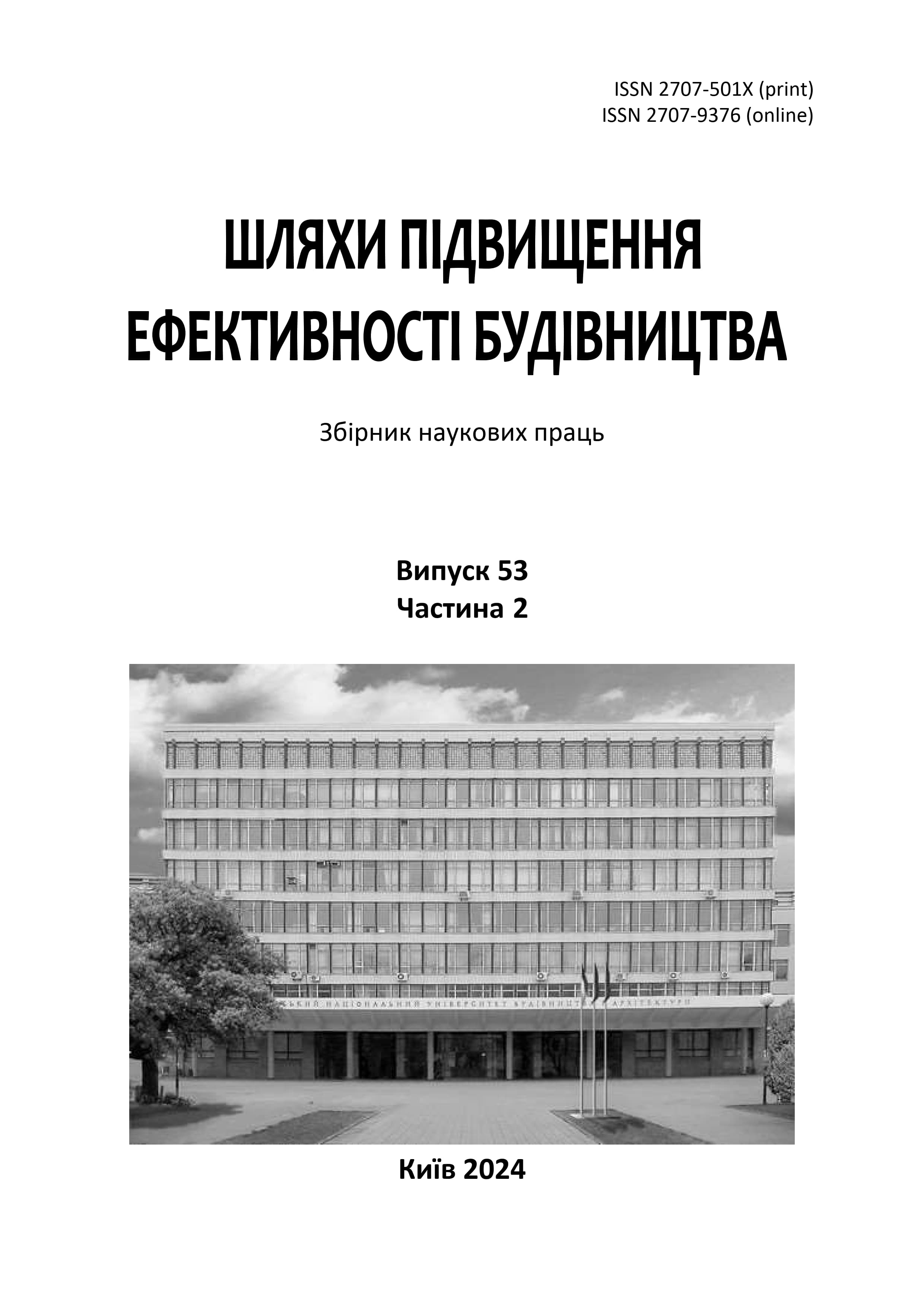Use of digital technologies to optimise the supply of construction materials and equipment
DOI:
https://doi.org/10.32347/2707-501x.2024.53(2).351-367Keywords:
digital transformation, supply chain management, process automation, Internet of Things, building information modelingAbstract
In the context of increasing project complexity, shorter implementation timelines, and external challenges such as global disruptions in supply chains, the application of digital technologies has become a necessary condition for ensuring the stability and competitiveness of construction enterprises. The relevance of the study lies in the need to overcome the limitations of traditional supply models, which often lack transparency, are characterized by poor coordination among stakeholders, and are vulnerable to delays and resource losses.
The aim of the article is to examine the capabilities and impact of digital technologies on optimizing supply processes in construction, particularly the use of integrated platforms, real-time tracking systems, data analytics, and automation tools. The study analyzes practical cases of digital technology implementation in both Ukrainian and international contexts, showing how technologies such as Building Information Modeling (BIM), the Internet of Things (IoT), cloud-based solutions, and artificial intelligence contribute to improving delivery accuracy, cost control, and flexibility of logistics decisions.
The results of the study showed that the implementation of digital tools leads to a significant increase in supply chain efficiency, a reduction in material losses and transportation costs, as well as greater resilience of construction operations in a dynamically changing environment. It is emphasized that the adoption of modern digital technologies will not only optimize the supply of construction materials and equipment but also modernize the entire industry.
The conclusions highlight that the digitalization of construction logistics is not only a technological upgrade but also a strategic transformation that requires organizational change, staff training, and the development of a supportive institutional framework. Ensuring successful implementation depends on a comprehensive approach that integrates technological innovation with new supply chain management models and industry-wide collaboration.
References
Войтович В., Поколенко В., Ємельянова O. Оптимізація логістичних процесів для підвищення продуктивності будівельної організації. Шляхи підвищення ефективності будівництва в умовах формування ринкових відносин. 2023. № 52(1). С. 34–40.
Чернишев Д., Приходько О., Аксельрод Р., Рижаков Д., Хоменко О., Петруха С. Розвиток науково-методологічних та аналітичних підходів щодо вияву впливу екоінновацій на рівень організаційно-технологічної надійності будівництва. Управління розвитком складних систем, 2021, (47), 138–150.
Семененко Ю. Оптимізація діяльності будівельної компанії з допомогою ІТ технологій. Економічний аналіз. 2024. № 34 (2). С. 250–258. DOI: https://doi.org/10.35774/econa2024.02.250
Мельник Л. М., Трофімчук С. М. Програмно-цільовий підхід до управління фінансово-економічною безпекою підприємств з виробництва будівельних матеріалів в умовах невизначеності. Modern Economics. 2024. № 48. С. 72–82.
Соколова Н. М., Штулер Ю. Ю. Інноваційні технології в діяльності будівельних підприємств та підвищення ефективності їх впровадження в умовах конкуренції та динамічних змін. Актуальні проблеми економіки. 2023. № 10(2). С. 65–71.
Птащенко Л.О. Модель інноваційного розвитку будівельного підприємства. Економіка і регіон. 2024. № 3 (94). С. 86–93.
Дружинін М., Степанюк Р., Антипенко Е. Формування аналітичних компонент інтегрованої реалізації будівельного проекту як цифрової екосистеми. Просторовий розвиток. 2024. № 10. С. 287–300.
Садовяк М. Б., Мазник Ю. І., Старецький А. О., Волос М. В. Цифровізація як фактор інтенсивного розвитку виробничого потенціалу підприємств будівельної індустрії. Академічні візії. 2024. № 28. DOI: https://doi.org/10.5281/zenodo.10667332
Галюк І., Ф. Єжак. Логістика будівництва та сталий розвиток: виклики та перспективи. Науковий вісник ІФНТУНГ. Серія: Економіка та управління в нафтовій і газовій промисловості. 2024. № 2 (30). С. 110–117.
Бреус С. В., Цимбаленко О. Е., Глухов М. О. (2024). Інформаційні технології: їх роль у зміні бізнес-парадигми компаній. Економіка та суспільство. 2024. Вип. 63. URL: https://doi.org/10.32782/2524-0072/2024-63-15
Сапожник Д. О., Плечистий Д. Д. Використання інтернету речей для економії енергетичних ресурсів. Вісник Вінницького політехнічного інституту. 2023. № 4. С. 39–45.
Малихін М. Оновлення класифікації та змісту аналітичних інструментів підготовки будівництва на ґрунті цифровізації. Шляхи підвищення ефективності будівництва в умовах формування ринкових відносин. 2023. № 52(2). С. 307–324.
Соломніков І. В., Овсяннікова І. В., Проценко В. О. Інноваційні перспективи розвитку будівельної галузі в сучасних умовах господарювання. Вісник економіки транспорту і промисловості. 2023. № 83. С. 147–157.
Цифровізація будівельної галузі. URL: https://cases.media/en/article/ cifrovizaciya-budivelnoyi-galuzi
Садовяк М. Б. Ключові вектори цифровізації у сфері будівництва. Наукові записки Львівського університету бізнесу та права. 2024. № 43. С. 87–96.
Клочко А. Цифрові технології в галузі архітектури і будівництва. Управління розвитком складних систем. 2021. № 48. С. 61–68.
Арутюнян І. А., Ажажа О. В., Кузнецов В. В., Арутюнян Є. Е. Розвиток інноваційних технологій в будівництві та цивільній інженерії в умовах цифровізації економіки України. Мости та тунелі: теорія, дослідження, практика. 2024. № 25. С. 5-12.
Downloads
Published
How to Cite
Issue
Section
License

This work is licensed under a Creative Commons Attribution 4.0 International License.
Authors who publish with this journal agree to the following terms:
- Authors retain copyright and grant the journal right of first publication with the work simultaneously licensed under a Creative Commons Attribution License that allows others to share the work with an acknowledgement of the work's authorship and initial publication in this journal.
- Authors are able to enter into separate, additional contractual arrangements for the non-exclusive distribution of the journal's published version of the work (e.g., post it to an institutional repository or publish it in a book), with an acknowledgement of its initial publication in this journal.
- Authors are permitted and encouraged to post their work online (e.g., in institutional repositories or on their website) prior to and during the submission process, as it can lead to productive exchanges, as well as earlier and greater citation of published work (See The Effect of Open Access).

